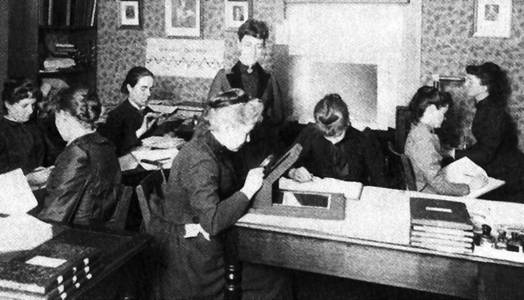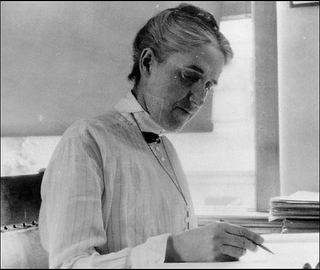By Gael Mariani
 One century ago, in 1912, an astronomer named Henrietta Swan Leavitt made a discovery that was to become one of the cornerstones of modern astronomical science. And yet, during her lifetime she received neither plaudits, nor acclaim, nor even serious recognition from her peers. Even today, she is little known, with not even a plaque hanging to commemorate her name at the Harvard College Observatory where she worked, and where her far-reaching breakthrough took place. The purpose of this article is not only to celebrate the centenary of Leavitt’s discovery, but in a humble way to help draw wider attention to a largely, and unjustly, unsung pioneer of modern astronomy.
One century ago, in 1912, an astronomer named Henrietta Swan Leavitt made a discovery that was to become one of the cornerstones of modern astronomical science. And yet, during her lifetime she received neither plaudits, nor acclaim, nor even serious recognition from her peers. Even today, she is little known, with not even a plaque hanging to commemorate her name at the Harvard College Observatory where she worked, and where her far-reaching breakthrough took place. The purpose of this article is not only to celebrate the centenary of Leavitt’s discovery, but in a humble way to help draw wider attention to a largely, and unjustly, unsung pioneer of modern astronomy.
Henrietta Swan Leavitt was born in Massachusetts in 1868 and entered Radcliffe, then named the Society for the Collegiate Instruction of Women, at the age of 20. The rigorous education she received, spanning from classical Greek to fine arts and philosophy, to analytical geometry and differential calculus, would have been sufficient to lead to a successful academic career – if she had been a man. Sadly, at that time, the scientific profession was almost exclusively a male prerogative: thus when Leavitt took up employment at the Harvard College Observatory in 1893 it was not as an astronomer, nor even a junior astronomical researcher, but as a lowly ‘computer’ whose job of cataloguing the brightness of stars more resembled book-keeping than research and was rewarded by the princely wage of 25 cents per hour, comparable to a servant’s pay at that time. Leavitt worked in a tiny, dingy office alongside a number of other highly-educated women relegated to similar routine tasks under the supervision of their boss, Edward Pickering, and known collectively as ‘Pickering’s harem’. Cecilia Payne, another Harvard ‘computer’ who would later make the revolutionary (and disparaged, at the time) discovery that the sun was composed largely of hydrogen, wrote that ‘Pickering chose his staff to work, not to think.’

But if Leavitt ever felt her own talents weren’t being put to good use, she never expressed it. She was a hard-working, serious-minded individual, little given to frivolous pursuits and selflessly devoted to her family, her church, and her career. Much of her work was with Cepheid variables, a type of star that goes through periods of relative brightness and dimness, of which she personally discovered many new examples – earning her the offhand praise of one Princeton astronomer who described her in a letter to Edward Pickering as ‘a variable star fiend’. Even the Washington Post facetiously likened her to Charles Frohman, a theatrical producer of the time famous for having launched many ‘stars’.
But the real discovery was yet to come. Whilst recording and cataloguing the data on her variable stars, Leavitt found that she could accurately and consistently relate the period of a given star’s brightness cycle to its absolute magnitude. The discovery of this simple and hitherto-unknown relationship made it possible, for the first time, to calculate their distance from Earth. Henrietta Leavitt had just become, in the words of George Johnson, author of the book Miss Leavitt’s Stars, ‘the woman who discovered how to measure the Universe’.
Leavitt’s discovery ignited a scientific powder trail whose blaze brought fame and glory to many of her peers: without it, Edwin Hubble might never have been able to show that the spiral nebula Andromeda was not located at the edge of our galaxy, as had been previously thought, but almost a million light years away. Nor might the Danish astronomer Ejnar Hertzsprung been able to measure the parallax of many of the nearby Cepheid variables; even though while using Leavitt’s discovery to his advantage, a slip of his pen is alleged to have caused him to underestimate the stars’ distance by a factor of 10.
Some of those closer to the heart of Leavitt’s discovery profited too – not least Edward Pickering, who as director of the Harvard College Observatory claimed the right of superiority over his minion by publishing her findings in his own name, effectively taking most of the credit. The statement, which appeared in a Harvard Circular in 1912, referred to Leavitt only as the person who had ‘prepared’ it. Pickering’s successor at the observatory, Harlow Shapley, gained fame six years later when he built on Leavitt’s discovery of the period-luminosity relation to redefine our knowledge of the Milky Way. Leavitt, without whose findings his would have not been possible, was once again barely mentioned.
 Little is known of Henrietta Leavitt’s personal feelings about the way she had been overstepped. Hers was a shy and somewhat unassuming personality, and women at that time, even highly educated and brilliantly talented women who in a fairer world would have been respected as equals by their male peers, were all too often resigned to taking a lesser role, and were often just quietly grateful to be given any sort of role at all. A possible insight into Henrietta’s private thoughts is offered by her reply to a census taker who, in January 1920, the year before her death, asked her to state her occupation. There might have been a hint of defiant pride in her answer, ‘Astronomer’. But to the end, despite never rising above the position of assistant, she never spoke out openly. She worked diligently away at her job, even as her hearing slowly failed and her health began to suffer. She had always been sickly; we will never know for sure to what degree, if any, her private sorrow or resentment contributed to the cancer that would eventually kill her at the age of just fifty-three – or whether, as George Johnson writes in Miss Leavitt’s Stars, she was simply ‘content to be a small part of a greater thing called science’.
Little is known of Henrietta Leavitt’s personal feelings about the way she had been overstepped. Hers was a shy and somewhat unassuming personality, and women at that time, even highly educated and brilliantly talented women who in a fairer world would have been respected as equals by their male peers, were all too often resigned to taking a lesser role, and were often just quietly grateful to be given any sort of role at all. A possible insight into Henrietta’s private thoughts is offered by her reply to a census taker who, in January 1920, the year before her death, asked her to state her occupation. There might have been a hint of defiant pride in her answer, ‘Astronomer’. But to the end, despite never rising above the position of assistant, she never spoke out openly. She worked diligently away at her job, even as her hearing slowly failed and her health began to suffer. She had always been sickly; we will never know for sure to what degree, if any, her private sorrow or resentment contributed to the cancer that would eventually kill her at the age of just fifty-three – or whether, as George Johnson writes in Miss Leavitt’s Stars, she was simply ‘content to be a small part of a greater thing called science’.
As she had lived quietly, unnoticed, so her death left barely a ripple among her peers: to the extent that when, in 1925, the Swedish mathematician Gösta Mittag-Leffler wrote her a letter: ‘Honoured Miss Leavitt, your admirable discovery ... has impressed me so deeply that I feel seriously inclined to nominate you to the Nobel Prize in Physics for 1926’, he had to be informed that she had in fact been dead for four years. As the Nobel Prize is not awarded posthumously, Leavitt never received her nomination. Instead, Harlow Shapley, the new director of the observatory, suggested in his reply to Mittag-Leffler that the real credit belonged to him, Shapley, for his interpretation of her findings.
Harlow Shapley would eventually have a supercluster named after him, while only a minor lunar crater and a virtual space theatre mark Henrietta Leavitt’s name. She appears only in footnotes and cursory references. When I contacted one leading UK astronomy magazine to inquire about any plans to celebrate the centenary of her discovery, the editor’s delayed reply was: ‘It had escaped my attention that it was 100 years since Henrietta Leavitt characterised the period-luminosity relation of Cepheid variables. Alas, we have not featured her in the magazine... Perhaps we can think about belatedly doing something, but the boat may have sailed’. Other magazine editors never replied at all.
A sad state of affairs, then. Yet one day, perhaps, this important figure in modern astronomy will finally be given the recognition she deserves.
Sources:
Miss Leavitt’s Stars, George Johnson, Atlas Books, W.W. Norton & Co., 2005
Nobel prize for a ‘computer’ named Henrietta Leavitt (1868-1921), Professor Pangratios Papacosta, AAS Committee on the Status of Women, online Journal of the American Astronomical Society

